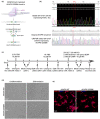Alzheimer's disease associated AKAP9 I2558M mutation alters posttranslational modification and interactome of tau and cellular functions in CRISPR-edited human neuronal cells
- PMID: 35567427
- PMCID: PMC9197405
- DOI: 10.1111/acel.13617
Alzheimer's disease associated AKAP9 I2558M mutation alters posttranslational modification and interactome of tau and cellular functions in CRISPR-edited human neuronal cells
Abstract
Alzheimer's disease (AD) is a pervasive neurodegeneration disease with high heritability. In this study, we employed CRISPR-Cas9-engineered technology to investigate the effects of a rare mutation (rs144662445) in the A kinase anchoring protein 9 (AKAP9) gene, which is associated with AD in African Americans (AA), on tau pathology and the tau interactome in SH-SY5Y P301L neuron-like cells. The mutation significantly increased the level of phosphorylated tau, specifically at the site Ser396/Ser404. Moreover, analyses of the tau interactome measured by affinity purification-mass spectrometry revealed that differentially expressed tau-interacting proteins in AKAP9 mutant cells were associated with RNA translation, RNA localization and oxidative activity, recapitulating the tau interactome signature previously reported with human AD brain samples. Importantly, these results were further validated by functional studies showing a significant reduction in protein synthesis activity and excessive oxidative stress in AKAP9 mutant compared with wild type cells in a tau-dependent manner, which are mirrored with pathological phenotype frequently seen in AD. Our results demonstrated specific effects of rs14462445 on mis-processing of tau and suggest a potential role of AKAP9 in AD pathogenesis.
Keywords: Alzheimer's disease; CRISPR; Tau; Tau interactome; a kinase anchoring protein 9; oxidative stress; phosphorylated tau; protein synthesis; proteomics.
© 2022 The Authors. Aging Cell published by the Anatomical Society and John Wiley & Sons Ltd.
Conflict of interest statement
The authors declare no conflicts of interest.
Figures







References
-
- Agholme, L. , Lindstrom, T. , Kagedal, K. , Marcusson, J. , & Hallbeck, M. (2010). An in vitro model for neuroscience: differentiation of SH‐SY5Y cells into cells with morphological and biochemical characteristics of mature neurons. Journal of Alzheimer's Disease, 20, 1069–1082. 10.3233/JAD-2010-091363 - DOI - PubMed
-
- Cavallini, A. , Brewerton, S. , Bell, A. , Sargent, S. , Glover, S. , Hardy, C. , Moore, R. , Calley, J. , Ramachandran, D. , Poidinger, M. et al (2013). An unbiased approach to identifying tau kinases that phosphorylate tau at sites associated with Alzheimer disease. Journal of Biological Chemistry, 288, 23331–23347. 10.1074/jbc.M113.463984 - DOI - PMC - PubMed
-
- de Calignon, A. , Polydoro, M. , Suarez‐Calvet, M. , William, C. , Adamowicz, D. H. , Kopeikina, K. J. , Pitstick, R. , Sahara, N. , Ashe, K. H. , Carlson, G. A. , Spires‐Jones, T. L. , & Hyman, B. T. (2012). Propagation of tau pathology in a model of early Alzheimer's disease. Neuron, 73, 685–697. 10.1016/j.neuron.2011.11.033 - DOI - PMC - PubMed
Publication types
MeSH terms
Substances
Grants and funding
- RF1 AG054199/AG/NIA NIH HHS/United States
- U01AG062602/AG/NIA NIH HHS/United States
- RF1AG057519/AG/NIA NIH HHS/United States
- R01AG048927/AG/NIA NIH HHS/United States
- P30AG013846/AG/NIA NIH HHS/United States
- U19AG068753/AG/NIA NIH HHS/United States
- U01AG058654/AG/NIA NIH HHS/United States
- RF1AG054199/AG/NIA NIH HHS/United States
- U19 AG068753/AG/NIA NIH HHS/United States
- R01AG066429/AG/NIA NIH HHS/United States
- U01AG032984/AG/NIA NIH HHS/United States
- R01AG054672/AG/NIA NIH HHS/United States
- R01AG067763/AG/NIA NIH HHS/United States
LinkOut - more resources
Full Text Sources
Medical
Molecular Biology Databases

